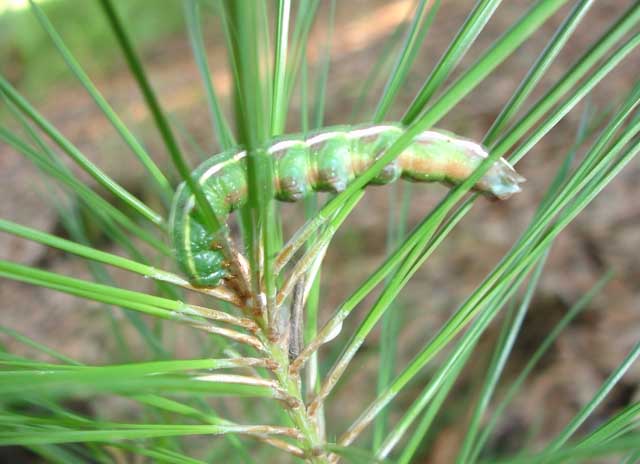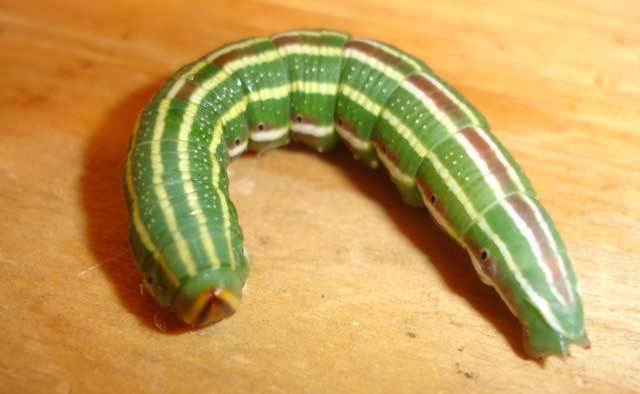Sphinginae subfamily
Sphingini tribe:
 |
Larvae feed on plants in the Convolvulaceae family, especially
Ipomoea batatas (sweet potato) and in the Solanaceae family,
especially (Datura) (jimsonweed) and related plants in the
Americas. There is also a brown form. Look for very large, dark
spiracular circles.
|
 |
Ceratomia amyntor
WO,
the Elm Sphinx or Four-horned Sphinx
Caterpillars show both brown and green forms and are unmistakeable
due to four horns on the thorax (near the head).
Larvae feed on Elm (Ulmus), birch (Betula), basswood (Tilia), and
cherry (Prunus). |
 |
This caterpillar is one of the few North American Sphingidae that
feed in large groups. Colouration is distinctive. The larvae
are much more spectacular than the moths. Catalpa is the larval host. |
 |
Note the pinkish-orange tail, spiracles outlined in red and the cream
stripes on the head.
The dramatic color change from the dorsal
yellow-green to the lateral light greyish-blue is not always
as intense as in this image.
|
 |
Note the smooth skin, blue-black horn and small black spiracles.
Pawpaw is the primary host. Littleleaf sweetfern, possum haw,
inkberry, tall gallberry holly and others are also utilized.
|

|
Isoparce cupressi
WO, Cypress or Baldcypress Sphinx.
Larvae feed on needles of baldcypress (Taxodium distichum) at night and
pupate in shallow underground burrows where second generation
overwinters.
|
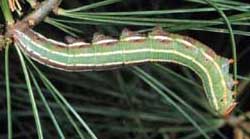 |
This caterpillar is also without the anal horn and feeds on pines.
The long stripes and reddish brown afford great camouflage.
|
Lapara coniferarum, Moncks Corner, on loblolly pine, June 3, 2012, Mike Connolly
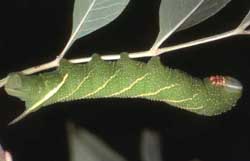 |
Larvae feed on ash in the Fraxinus genus. Syringa and Ulmus have
also been reported.
Note the black anal horn.
|
 |
Manduca quinquemaculatus
WO,
the Five-spotted Hawkmoth
Note the solid black horn and dark spiracular rings. In addition to the white
oblique lines, there are fainter white rings, especially on the back.
I suspect if you grow tomatoes, you are likely to encounter it.
|
 |
Note the green horn, raised white bumps and strong dark lines
anterior to the white ones.
|
 |
Note the red horn and black dots anterior to the white oblique lines.
If you grow tomatoes, you have probably encountered it.
|
 | Larvae feed at night, hiding on the underside of stems during the
day. Preferred hosts are common trumpetcreeper (Campsis radicans),
Florida yellow-trumpet (Tecoma stans), lilac
(Syringa species), and passionflower (Passiflora species). Questionable
|
Smerinthini Tribe:
 |
Amorpha juglandis larvae feed upon Walnut and butternut (Juglans),
hickory (Carya), alder (Alnus), beech (Fagus),
hazelnut (Corylus), and hop-hornbeam (Ostrya).
|
 |
Pachysphinx modesta
WO,
the Modest Sphinx or Poplar Sphinx
This moth is not officially recorded in your county. Larvae are
sometimes found on poplars and
willows.
|
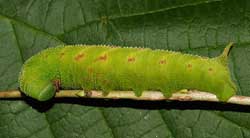 |
The Huckleberry Sphinx
Blueberry and huckleberry (Vaccinium), cherries (Prunus) and
willows (Salix) are the favorites as larval foodplants.
|
 |
Larvae accept willows, birches, and cherries.
I have also found them in the wild on oak in eastern Canada.
|
 |
Wild cherry species are the favorites as larval foodplants, but eggs
will also be deposited on birches and other forest trees.
There are varying degrees in the amount of red markings along the
sides.
|
 |
Larvae feed upon many forest trees including birches and cherries,
but are expecially fond of poplars and willows. Red markings on sides
vary greatly from specimen to specimen.
|
Macroglossinae subfamily
Dilophonotini tribe:
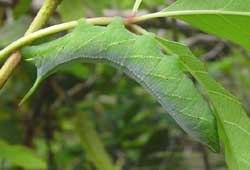 |
Larvae probably feed on
Vitus tiliifolia and other members of the Vitaceae family:
Vitis, Cissus, Ampelopsis. In Florida larvae have been
reported on larvae on Possum Vine
(Cissus sicyoides) and Pepper Vine (Ampelopsis arborea). rare stray
|
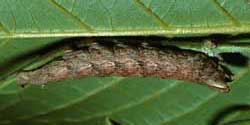 |
Erinnyis obscura, the Obscure Sphinx,
WO
Larvae feed on Rauvolfia ligustrina, Rauvolfia tetraphylla,
Stemmadenia obovata, Philibertia, Cynanchum, papaya
(Carica papaya), Asclepiadaceae, Blepharodon mucronatum,
White vine (Sarcostemma clausum) and Morrenia odorata.
rare stray
|
See Hemaris comparison to help distinguish
the next three species.
 |
Hemaris thysbe
WO, the Hummingbird Clearwing
There is also an orangey-pink prepupal form. The lateral line runs
from S1 to the blue horn.
Hemaris thysbe larvae feed on viburnum and related plants.
|
 |
Hemaris diffinis
WO, the
Snowberry Clearwing or Bumblebee Moth
Larval host plants include Snowberry (Symphoricarpos),
honeysuckle (Lonicera), Coralberry, viburnums, Blue Dogbane
(Apocynum) and dwarf bush honeysuckle (Diervilla lonicera).
Horn is black with a yellow base.
|
 |
Hemaris gracilis WO, the
Slender Clearwing or Graceful Clearwing
Hemaris gracilis is distinguished from similar species by a pair of
red-brown bands on the undersides of the thorax, which varies from
green to yellow-green dorsally and sometimes brown with white
underneath. They have a red abdomen. unlikely
|
Philampelini tribe:
 |
Larvae feed upon Grape (Vitis), Virginia Creeper
(Parthenocissus quinquefolia) and other vines and ivies
(Ampelopsis).
Larvae occur in both a light (green) form and a darker (tan/brown)
form. Note six "segmented" oblique lines.
|
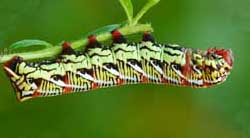 |
Eumorpha fasciatus
BAMONA, the Banded Sphinx
Larvae feed upon primrose-willow, Ludwigia (water primrose)
and other plants in the evening primrose family. This hornless larva is
highly variable. Look for large, dark spiracular circles and a dark
line in the center of the back. See image at bottom of this page.
|
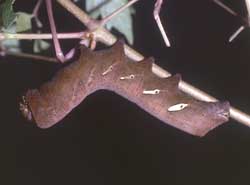 |
Eumorpha intermedia
WO, the Intermediate Sphinx.
Eumorpha intermedia larvae feed upon peppervine, Ampelopsis arborea. Possibly they will also accept grape (Vitis species),
but so far no records of that host have been reported to my knowledge.
They like to remain well hidden within tangle of vines and probably feed mostly at night.
|
 |
If you have Grape or Virginia Creeper nearby, then you might encounter
this species. Note the five large white ovals. There are orangey-brown and green
forms also. |
Macroglossini tribe:
 |
In additon to Virginia creeper larvae accept Grape (Vitis),
ampelopsis (Ampelopsis), and cayenne pepper (Capsicum).
Larvae are green until the final instar.
|
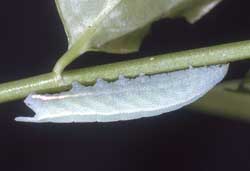 |
Cautethia grotei
WO; unlikely,
the Grote's Sphinx.
Rare in U.S., but there are sightings (mostly of adult moths)
in the east from Florida, South Carolina, New Jersey, New York,
Massachusetts and
New Hampshire. Larvae feed on David's milkberry/snowberry (Chiococca alba)
in the madder family (Rubiaceae) and have also been found on black torch (Erithalis fruiticosa) and Common Snowberry (Symphoricarpos albus).
|
 |
Larvae feed on Azalea and Viburnum and progress very rapidly. The
larva to the left on Viburnum cassinoides is getting ready to
pupate. Color change from green to light burgundy-brown indicates
pupation is imminent.
|
 |
Darapsa myron
WO, the Virginia Creeper Sphinx or the
Grapevine Sphinx
If you have the
foodplants indicated in the common names, you probably have this
species nearby. The lower wings are orange.
Larvae feed on Virginia creeper (Parthenocissus quinquefolia),
Grape (Vitis), Ampelopsis, and Viburnum.
|
 |
Larvae feed on Smooth hydrangea (Hydrangea arborescens),
buttonbush (Cephalanthus occidentalis), and waterwillow
(Decodon verticillatus).
Note small head which can be retracted into the thorax.
|
 |
Grape (Vitis), ampelopsis (Ampelopsis), and
Virginia creeper (Parthenocissus) all serve as larval hosts.
The alternating yellow and greyish-green rings across the back
distinguish this larva.
|
 |
Hyles lineata
WO, the White-lined Sphinx
Larvae are highly varied and feed on a great diversity of plants
including willow weed (Epilobium), four o'clock (Mirabilis),
apple (Malus), evening primrose (Oenothera), elm
(Ulmus), grape (Vitis), tomato (Lycopersicon),
purslane (Portulaca), and Fuschia.
All larvae seem, however, to have the red/black swellings split by
dorso-lateral lines.
|
 |
Larvae feed at night on grape (Vitis) and ampelopsis
(Ampelopsis) and hide on the bark of their host plants during
the day. Virginia creeper would also be a suitable host. There is also a dark form
without the green patches. Note the "raised eye", replacing the anal horn.
|
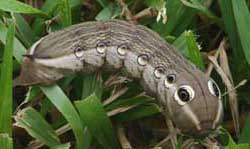 |
Larvae feed on Borreria, Catalpa
and Manettia spp. and
Smooth buttonplant (Spermacoce glabra) and starclusters
(Pentas species). They are also recorded on joe-pie weed and
Hamelia patens and on Hedoydis nigricans. The green form may be more
common.
|
|
|
